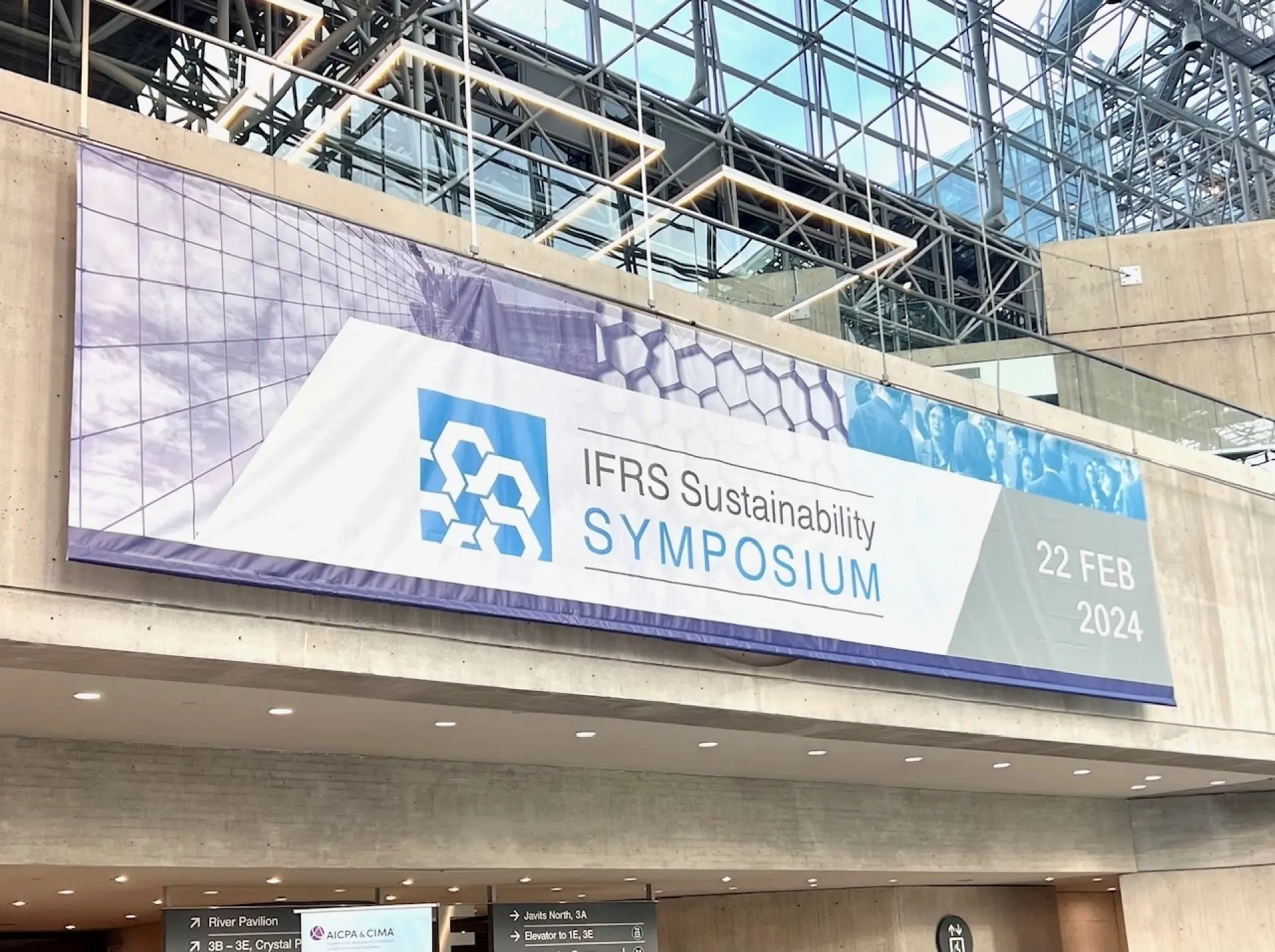
27 February 2024
A Common Language for ESG Disclosure: Updates from the 2024 IFRS Sustainability Symposium
Around 1,000 companies, investors, regulators, and other key stakeholders from over 50 global jurisdictions gathered at the IFRS Sustainability Symposium in New York City on February 22 to exchange insights on the introduction and adoption of the International Sustainability Standards Board (ISSB) Standards (more formally called the IFRS Sustainability Standards). We attended and listened to how both investors and policymakers around the globe are getting ready to adopt the standards in their investment decision-making and regulatory frameworks. We also heard from corporate reporters about how they are internally organizing their teams and prioritizing resources to meet the expectations of a new era of sustainability and financial information living side-by-side.
What are the ISSB Standards?
The ISSB has released sustainability reporting standards (IFRS S1 and IFRS S2) that facilitate targeted, decision-useful information specifically for capital markets, enabling a global baseline and comparison for investors. Rather than compliance, the ISSB standards promote “effective communication around value creation” and are inherently connected to financial reporting.
There is a high degree of alignment in climate-related disclosure requirements in the ISSB Standards and the European Sustainability Reporting Standards (ESRS), which are the roadmap for compliance with the EU Corporate Sustainability Reporting Directive (CSRD). There are also interoperability mechanisms established between the Standards, which aim to reduce complexity and duplication for companies required or choosing to apply both sets of standards in their reporting.
IFRS S1 asks for disclosure of material information about a company’s sustainability-related risks and opportunities, using the same definition of materiality that is used in IFRS Accounting Standards (information that, if absent, obscured, or misstated, could be reasonably expected to influence investor decisions). IFRS S2 asks for disclosure of material information about climate-related risks and opportunities, including disclosure about physical risks (such as flood risk), transition risks (such as regulatory change), and climate-related opportunities (such as new technologies). Both S1 and S2 use the same structure as the Task Force on Climate-related Financial Disclosures (TCFD)— governance, strategy, risk management, and metrics and targets. IFRS S1 and S2 fully incorporate the TCFD recommendations and, for reporting periods beginning in 2024, will be applied globally.
How investors view the standards
The ISSB Standards are designed to enable companies to apply the requirements irrespective of which financial accounting standards they use so that they can produce more comprehensive and streamlined general purpose financial reports that meet the needs of investors globally and domestically. An important signal of investor support and adoption of the ISSB Standards came when the Financial Stability Board (FSB) announced that they would transfer the responsibility of monitoring progress on companies’ climate related disclosures from the TCFD to the ISSB.
At this year’s Symposium, we heard from a wide array of investors such as Northern Trust, Addenda Capital, and Oak Hill Advisors on the ways they concretely integrate sustainability information into their investment decision-making. It was frequently brought up that material ESG factors are viewed as “pre-financial indicators” (issues that will eventually become financially material over a certain time horizon) and that having access to more standardized and comparable data such as the kind supported by the ISSB Standards can better inform valuations and stewardship priorities for long-term assets. We also heard that the investment processes that have long used the industry-specific materiality framework from SASB Standards will continue to rely on their updates and enhancements under the IFRS.
Inaugural Jurisdiction Guide
Another bellwether event for the ISSB included an endorsement from the International Organization for Securities Commissions (IOSCO) back in February 2023, which unleashed the potential for the standards to reach more than 140 countries. Juridictions that have already adopted or are in process of adopting the standards include Australia, Brazil Canada, Japan, Mexico, and the UK.
During the Symposium, one of the larger announcements was the publication of The Preview of the Inaugural Jurisdictional Guide, which aims to support jurisdictions by providing information that they may find helpful as they design and plan their journey to the adoption or other use of ISSB Standards as well as support transparency to capital markets, regulators, and other stakeholders on this progress. The final Jurisdictional Guide, which will be published before the end of June, will also better equip the IFRS Foundation to undertake and coordinate its own efforts to support international regulators and organizations (including the Monitoring Board of the IFRS Foundation, IOSCO, and the FSB) in encouraging and monitoring the adoption or other use of standards in a way that promotes globally consistent and comparable climate and other sustainability-related disclosures for investors.
“Get ready”
Beyond the theme of capital markets learning a new language to communicate value when it comes to sustainability-related information, the other dominant message at this year’s Symposium was centered on a call to action to prepare for and support widespread use of the ISSB Standards. Companies need to start or continue to explain the risks and opportunities in their sustainable transitions to attract investment. Consistent, comparable, and decision-useful sustainability disclosure will unlock these capital flows.
Although sustainability disclosure remains largely voluntary in several countries, such as the US, we are already seeing more climate disclosure regulations like California’s quickly change what was voluntary to now mandatory. For example, Emmanuel Faber, ISSB Chairman, said the “train has left the station” when it comes to mandatory Scope 3 emissions and reporting, despite the challenges in accounting for them and despite what the SEC may include in its final climate rule. For companies already familiar with and accustomed to using the SASB Standards and the TCFD framework in their ESG reporting, aligning with the ISSB Standards starting next year is not only the natural next step—it will quickly become the expectation.